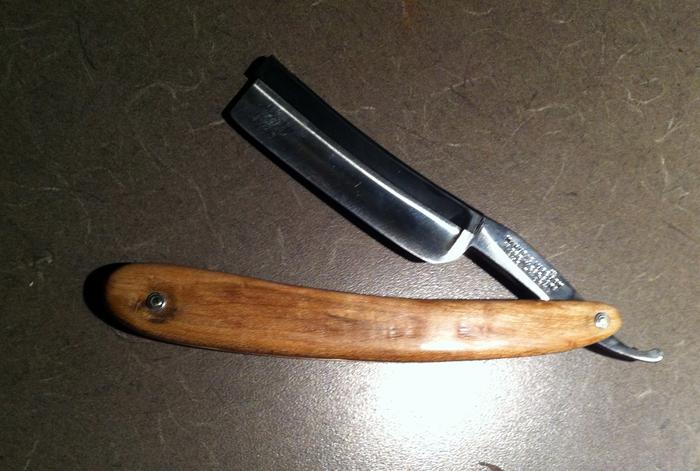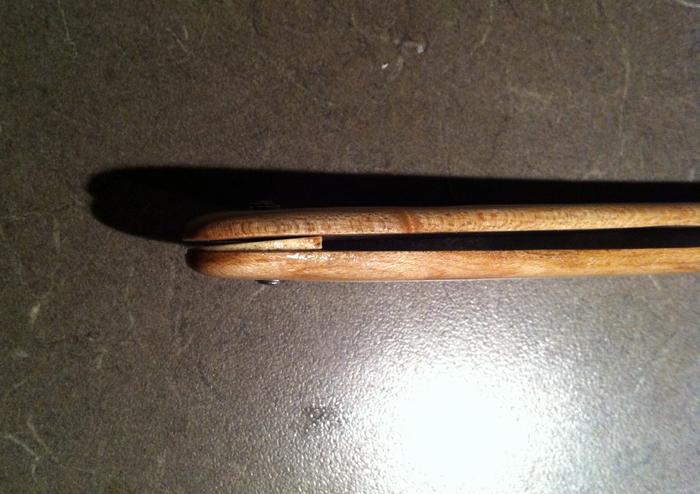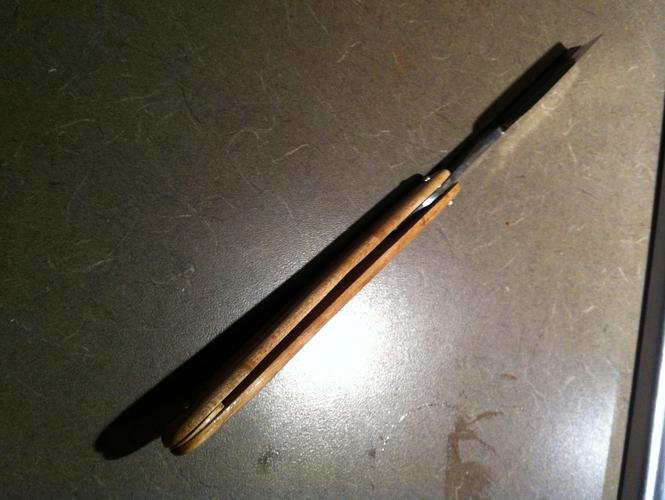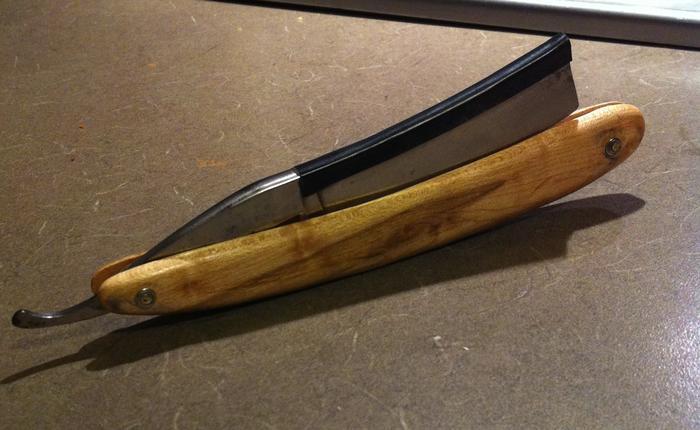Results 1 to 5 of 5
Thread: Second Set of scales attempt...
-
02-16-2014, 03:35 AM #1Senior Member


- Join Date
- Nov 2010
- Location
- Pequea, Pennsylvania
- Posts
- 2,290
Thanked: 375 Second Set of scales attempt...
Second Set of scales attempt...
So I attempted to make a set of scales the other day....
I used maple, traced the old scale that wasn't broken, made it a little shorter in length, then thinned them out using a make shift planer out of my drill press and drum sander. Used the original wedge, drilled holes for the pin's, and put a CA finish on them.
Here's my issues or where I think I went wrong....
I think the scales are still to thick. B
oth scales were stuck together when I drilled the holes for the pin's but the wedge end is, off.
When I close the razor, and this is why I think my scales are still to thick the blade just sets and does not fall between the scales as far as they should.
Bent the pin's, I need a dapping block I guess - pinning is not for people who have no patience for small parts...
At any rate an attempt... not the result I wanted but then again I would rather have some bone or antler scales on this Greaves....
Any suggestion's? Feel free to make rude comments
I may just stick to turning brush handles on the lathe....



 CHRIS
CHRIS
-
02-16-2014, 04:06 AM #2Senior Member




- Join Date
- Feb 2013
- Location
- Haida Gwaii, British Columbia, Canada
- Posts
- 14,457
Thanked: 4830
I have a couple of ideas. Your scales look too stiff for the wedge to do its job, which means they need to be thinner. I had done a lot of woodwork and had a lot of experience dealing with really little parts, so I thought pinning would be easy. The hardest part is to learn the length of pin to give you the right amount to peen over without having to peen too much, because that's when I bend the pin. I sometimes trim the pin a tiny bit with a file it it's looking too long when I'm peening. The part with the alignment of the pins to get a nice fit, I do a little different than I have seen others do. I don't drill my wedge pin until after I've fitted and aligned my wedge. So many of my old razors don't have the pivot hole straight. That thrown the alignment off at the wedge. I use double sided tape on the wedge to get it into the right position with the scales lined up and a screw in the pivot holding the blade in. It allows me to adjust how the blade sits in the scales too, so it's always dead center. Once I'm happy with the alignment, I remove the blade and drill the wedge pin halfway through each side. I remove the tape and put screws in to check the alignment and make any adjustments. Then I glue the wedge and then pin the wedge and the blade. It has been working for me so far.
P.S.
Sometimes you have to do some minor reshaping of wedge end.It's not what you know, it's who you take fishing!
-
The Following User Says Thank You to RezDog For This Useful Post:
Trimmy72 (02-16-2014)
-
02-16-2014, 04:46 AM #3

since you're reusing an old wedge with new scales there is a relatively simple way to align the hole you're drilling. Just match the wedge up to the end of the scale, then mark the hole with a pencil. Lay the scale down flat and drill as close to vertical as possible. repeat with the other side.
The wedge side does not take as much accuracy as the pivot side of the scales when making the holes line up to an acceptable angle.
-
The Following User Says Thank You to TwistedOak For This Useful Post:
Trimmy72 (02-16-2014)
-
02-16-2014, 04:59 AM #4

I like to make my scales around 2.5mm thick for wood and it seems to work out well with the balance and flex. When I first started making scales I had the same problem and I found it happened alot when I would pin the pivot first and then the wedge. You need to remember that the scales balance out the razor also, so keep that in mind when making them. If you have the scales finished and you find that you need more weight try a heavier wedge. Gluing one side of the wedge can help hold it tight also.
-
-
02-16-2014, 05:50 AM #5

Growing up in construction my dad always told me "If you have to bend it to make it fit. It doesn't fit, and to go find the part that fits." You replaced the scale. Maybe the wedge needs replaced too. I didn't see the scales pre-repair, but maybe they were warped around the wedge. At the same time I've never made scales or worked with wood much for that matter. I have worked with rebar and rough metal though and if two pieces need bent in order to meet at a mutual point they should both be arched in the same pattern in order to meet structural requirements. If one scale is flattened from being disassembled and you put a wedge that is supposed to curve the inner plane of both sides of the scale then maybe the method needs refining. Just a few observations.


 5Likes
5Likes
 LinkBack URL
LinkBack URL About LinkBacks
About LinkBacks






 Reply With Quote
Reply With Quote
